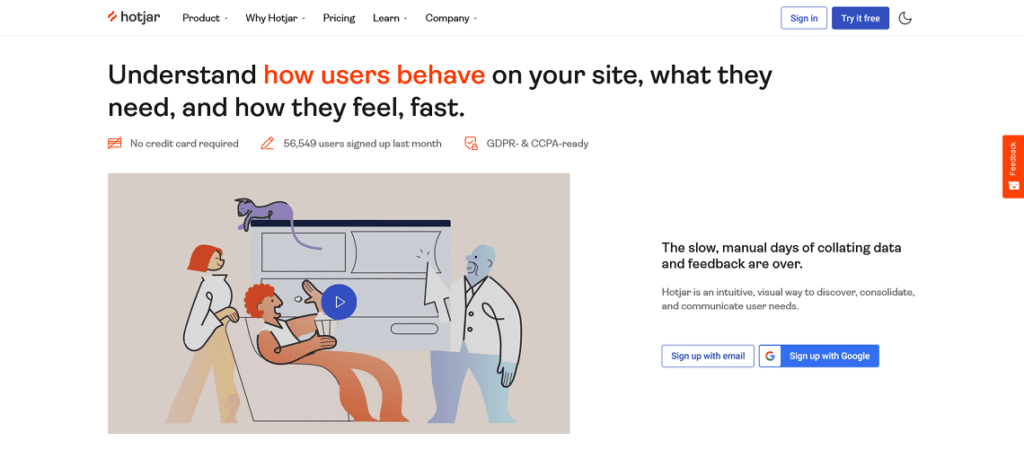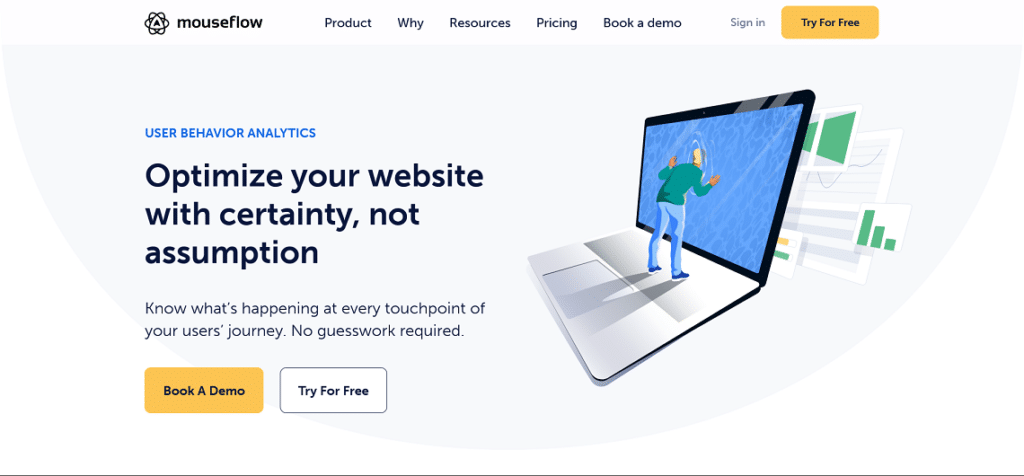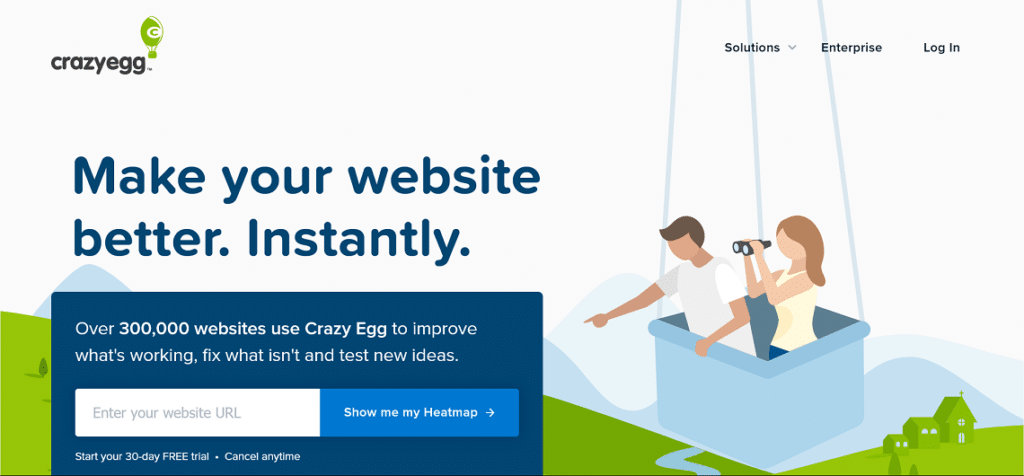33 Best Session Replay Tools in 2024
Have you ever felt frustrated with low conversion rates and puzzled over the reasons behind user drop-offs?
Did you know that, on average, 69.57% of users abandon their online shopping carts? Quite shocking, right? That’s where session replay software comes in as a game changer.
In this listicle, we’ll explore the top session replay software to help you analyze user behavior and optimize your website so you can finally say goodbye to those pesky cart abandonment issues. Let’s dive in!
Top Session Replay Software
Do you have a session replay tool?
Methodology
The ranking of the session replay software is determined by considering several factors, including the number of citations and user reviews they have received.
Most used Session Replay Tools
1.
Hotjar is a popular session replay software that lets website owners gain insights into user behavior. Key benefits include:
- Session replays: Visualize user interactions on your site through recorded sessions, making it easier to identify pain points.
- Heatmaps: Understand where users click, scroll, and interact the most, optimizing your site for better engagement.
- Conversion funnels: Analyze drop-off points in your conversion funnel to identify areas for improvement and boost conversions.
- Feedback polls: Collect user feedback directly on your site to better understand their needs and preferences.
- Form analysis: Gain insights into form performance and identify fields causing friction to improve user experience.
Pricing: Free/Paid
Pricing page: https://www.hotjar.com/pricing/

2.
FullStory is a powerful session replay software designed to help businesses understand user behavior on their websites. Key benefits include:
- High-quality session replays: Watch recordings of user interactions on your site to identify issues and opportunities for improvement.
- Advanced search: Find and analyze specific user sessions based on filters and criteria.
- Click maps & heatmaps: Visualize user engagement and identify popular areas on your site for better optimization.
- Error & performance monitoring: Identify and troubleshoot technical issues affecting user experience and site performance.
- Omni-search: Gain a holistic view of user data, making it easy to pinpoint trends and areas for improvement.
Pricing: Paid
Pricing page: https://www.fullstory.com/plans/

3.
Smartlook is an intuitive session replay software that offers valuable insights into user behavior on websites and apps. Key benefits include:
- Easy-to-use interface: Analyze user sessions with a user-friendly dashboard and accessible tools.
- Event tracking: Automatically track important user events and interactions for in-depth analysis.
- Funnels & cohorts: Identify bottlenecks and optimize conversion funnels by visualizing user behavior through various stages.
- Mobile app support: Analyze user sessions on both websites and mobile apps for a comprehensive view of user experience.
- Integrations: Seamlessly integrate Smartlook with popular analytics, customer support, and project management tools for streamlined workflows.
Pricing: Free/Paid
Pricing page: https://www.smartlook.com/pricing/

4.
Mouseflow is a powerful session replay software designed to help you understand user behavior on your website. Key benefits include:
- High-quality replays: Visualize user interactions with accurate, real-time session replays.
- Heatmaps: Identify areas of user engagement with click, movement, and scroll heatmaps for data-driven optimization.
- Form analytics: Analyze form performance and identify bottlenecks to improve conversion rates.
- Funnels: Track and visualize user journeys through your website to pinpoint areas for improvement.
- Customizable filters: Use powerful filtering options to segment data and gain insights into specific user behaviors.
Pricing: Free/Paid
Pricing page: https://mouseflow.com/pricing/

5.
Crazy Egg is an intuitive session replay software that helps you visualize user behavior and optimize your website. Key benefits include:
- Heatmaps: Gain insights into user engagement with click, scroll, and mouse movement heatmaps.
- Snapshots: Capture detailed visual reports of user interactions for data-driven analysis.
- A/B testing: Test different website versions to optimize layout, content, and design for better conversions.
- Confetti reports: Visualize individual click data to understand visitor segments and behavior patterns.
- User-friendly interface: Easily navigate and interpret data with a clean dashboard.
Pricing: Paid
Pricing page: https://www.crazyegg.com/pricing

Further reading
What Is Session Replay?
Session replay, AKA session recording, is a tool that allows teams to monitor and learn from the behavior of individual users.
A session replay provides a visual approach to understanding what’s happening on your website, whereas traditional analytics tools give data such as bounce rates, clicks, and views.
It’s possible to see what your visitors are attempting to do, their journey, and what needs to be changed by looking at things from their perspective.
How Does a Session Replay Work?
A user’s interaction with your website is considered an event each time. A complete log of these events is recorded. It’s like keeping a book or diary of every action a person performs on a website.
This log also contains information about the website’s overall layout and design. The log records both the events and the structural changes that occur on your website. A session replay recreates the user’s
What Makes Session Replay Tools So Worthwhile?
Learn how to boost conversions
You can use session replay tools to accurately understand how real people use your site. For example, after a few replays, it may become apparent that customers are scrolling over an important CTA button or viewing a product page without going through the marketing and conversion funnel.
Using this information, you can modify the user experience, leading to increased conversion rates.
Find visitors’ pain points
Replaying a user’s session can help you discover where they’re having trouble. Finding these sources of friction can help you design a user-friendly website that makes it simple for them to see what they’re looking for. Visitors are more likely to stay on your website and make a purchase if you use this technique.
To identify where your website or app causes friction, it is necessary to watch session replays and spot behaviors like multi-click or bird’s nest. Modern session replay with behavior detection replaces the need for hours of manual scanning for these behavioral indicators.

Reveal bugs
Session replays uncover website bugs since they show you exactly what the user experienced on their screen. Identifying bugs on your website can help you fix underlying problems that may lead visitors to leave your site without converting out of frustration.
Wrap Up
And there you have it, folks – our round-up of the best session replay software on the market.
By now, you should clearly understand how these powerful tools can help you unlock valuable insights into user behavior, enhance the overall UX, and boost those conversion rates.
So, whether you’re eyeing Hotjar, FullStory, or any other stellar options we’ve discussed, remember to pick the one that best aligns with your unique needs and goals.
Happy analyzing, and here’s to conquering that cart abandonment problem once and for all!
FAQs
Session replay software is a tool or platform that enables website owners and digital marketers to record and visually replay individual user sessions on their website or application. These tools help businesses understand user behavior, identify usability issues, and optimize the user experience, ultimately improving conversion rates and customer satisfaction.
Organizations need session replay software to gain insights into how users interact with their website or application. By understanding user behavior, businesses can identify pain points, fix usability issues, improve website design, and optimize the user experience to increase conversions, reduce bounce rates, and enhance customer satisfaction.
Key features of session replay software include:
• User session recording: Records individual user sessions, including clicks, scrolls, and mouse movements, providing a visual representation of user interactions.
• Playback and navigation: Allows users to view, pause, and navigate through recorded sessions, enabling in-depth analysis of user behavior.
• Heatmaps: Generates visual representations of user interactions, such as click, scroll, and mouse movement heatmaps, to identify areas of high and low engagement.
• Funnel analysis: Helps users analyze user behavior through specific conversion funnels, identifying areas where users drop off or encounter issues.
• Segmentation and filtering: This enables users to segment and filter recorded sessions based on various criteria, such as location, device type, and user behavior.
• Integration capabilities: Seamlessly integrates with tools and systems like web analytics, A/B testing, and customer support platforms.
Some of the best session replay software options include FullStory, Hotjar, Smartlook, Mouseflow, and Inspectlet. These tools cater to different user needs, budgets, and levels of expertise, offering a range of features and capabilities.
To choose the right session replay software for your organization, consider factors such as your budget, the size of your website or application, the complexity of your user experience, and your specific analysis needs. Look for tools that offer the features and capabilities most relevant to your organization, and use free trials or demos to evaluate each tool’s suitability.
Yes, session replay software suits websites and applications of all sizes, from small businesses to large enterprises. Many session replay tools offer scalable features and pricing plans that cater to different website and application sizes, ensuring that organizations can find a solution that meets their needs and budget.
Reputable session replay software tools prioritize data privacy and security by implementing various measures, such as data encryption, secure data storage, access controls, and compliance with relevant data protection regulations (e.g., GDPR). These tools often offer options to anonymize or exclude sensitive user data during session recording. Before choosing a session replay software, review its privacy policy and security features to protect your users’ data.
While session replay software can potentially impact website performance, most reputable tools are designed to minimize this impact by using asynchronous loading, lightweight scripts, and efficient data processing. To ensure the best possible user experience, choose a session replay tool with a proven track record of minimal performance impact and test its impact on your website or application during the evaluation period.





